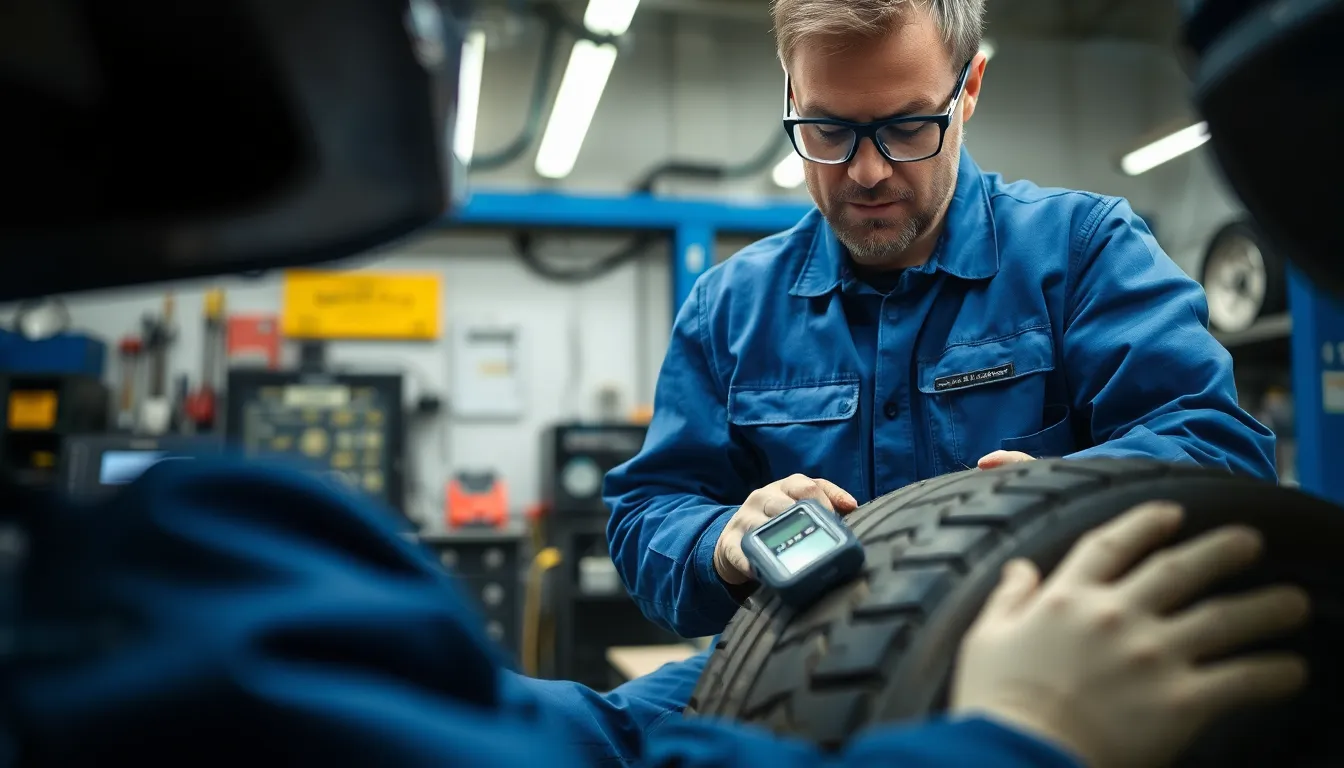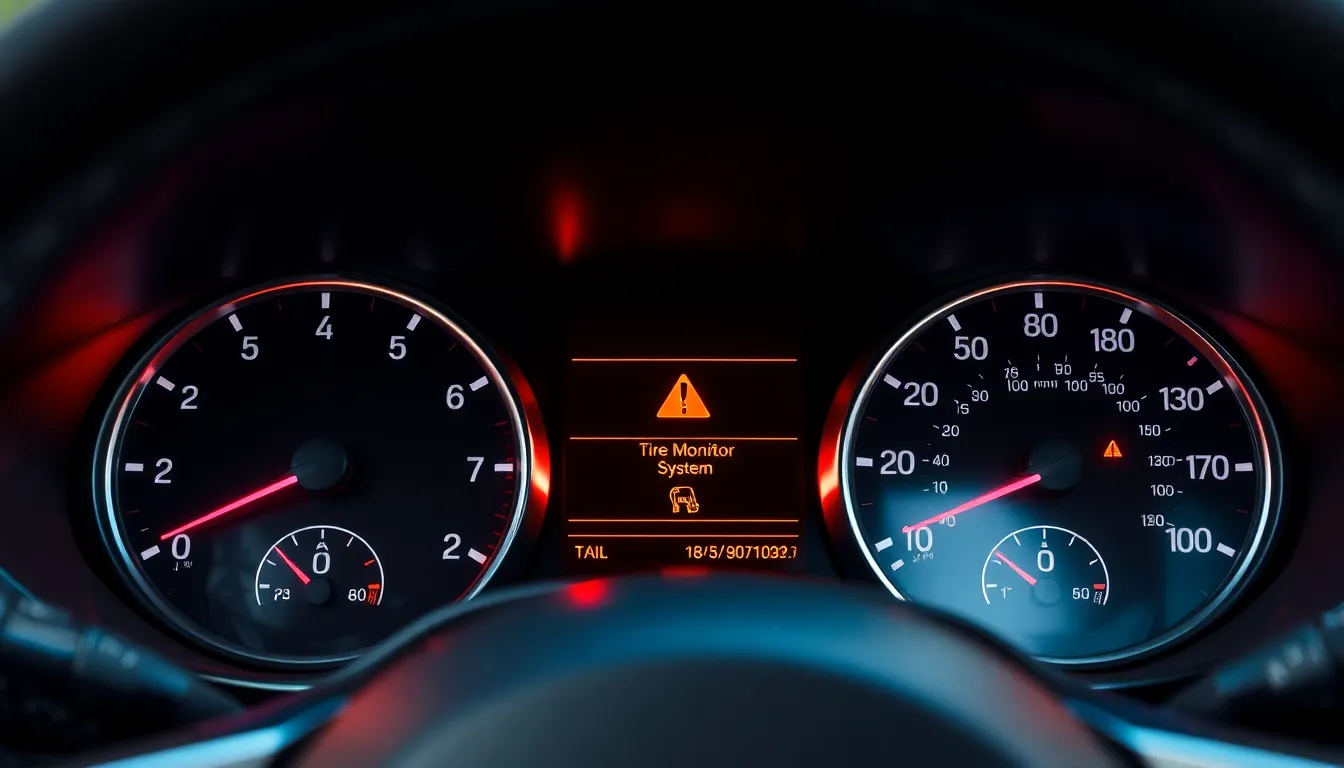We’ve all seen that mysterious “Service Tire Monitor System” warning pop up on our dashboard at some point. While it might seem like just another confusing automotive message we can ignore, this warning actually plays a crucial role in keeping us safe on the road. Understanding what this system does and why it needs servicing can save us from dangerous blowouts and costly tire replacements.
Modern vehicles come equipped with sophisticated tire pressure monitoring systems (TPMS) that constantly watch over our tire health. When this system detects issues or malfunctions within its own components, it triggers the service warning we’re seeing. Rather than panicking or dismissing this alert, we need to understand what’s happening under the hood.
The good news? Most tire monitor system issues are straightforward to diagnose and fix. We’ll walk you through everything you need to know about this warning, from common causes to practical answers that’ll get you back on the road safely.
What Does Service Tire Monitor System Mean
Service tire monitor system indicates your vehicle’s tire pressure monitoring system (TPMS) requires immediate attention. The warning appears on your dashboard when the system detects a malfunction in its sensors, wiring, or control module rather than just low tire pressure.
TPMS continuously tracks tire pressure and temperature across all four wheels using electronic sensors. These sensors transmit data to your vehicle’s computer system every few seconds while driving. Modern vehicles manufactured after 2007 include this federally mandated safety feature to prevent tire-related accidents.
Two distinct types of TPMS operate in today’s vehicles:
Direct TPMS uses pressure sensors mounted inside each tire to measure actual air pressure. Each sensor contains a battery, pressure gauge, and radio transmitter that sends real-time data to your dashboard display.
Indirect TPMS monitors wheel speed through your vehicle’s anti-lock braking system (ABS) sensors. The system calculates tire pressure by analyzing rotation speed differences between wheels since underinflated tires rotate faster than properly inflated ones.
Your dashboard displays exact warning messages when TPMS malfunctions occur:
| Warning Type | Display Message | Meaning |
|---|---|---|
| System Malfunction | “Service Tire Monitor System” | TPMS sensors or components need repair |
| Sensor Battery Low | “TPMS Battery Low” | Individual sensor batteries require replacement |
| Communication Error | “Tire Pressure System Fault” | Signal transmission problems between sensors and computer |
Service requirements become necessary when sensors fail due to dead batteries, physical damage, or corrosion. Battery life in TPMS sensors typically lasts 5 to 10 years depending on driving conditions and climate exposure. Extreme temperatures, road salt, and frequent tire changes accelerate sensor deterioration.
Professional diagnosis identifies exact failure points within your TPMS network. Technicians use specialized scan tools to communicate with individual sensors and pinpoint malfunctioning components. Replacement costs range from $50 to $200 per sensor depending on your vehicle’s make and model.
How the Tire Pressure Monitoring System Works

The TPMS operates through two distinct technologies that monitor tire conditions using different measurement approaches. Both systems provide crucial safety data to drivers through dashboard alerts when tire pressure drops below recommended levels.
Direct TPMS Technology
Direct TPMS employs pressure sensors mounted inside each tire to measure actual air pressure readings. These sensors transmit real-time data wirelessly to a central control module that processes the information and displays warnings on the dashboard. Each sensor contains a battery that typically lasts 5-10 years before requiring replacement.
The system delivers precise pressure measurements in pounds per square inch (PSI) rather than estimated values. Direct TPMS sensors also monitor tire temperature alongside pressure readings to provide comprehensive tire health data. Installation requires specialized equipment to mount sensors inside the tire during mounting or remounting procedures.
Calibration occurs automatically when sensors communicate with the vehicle’s computer system during normal driving conditions. The technology maintains accuracy regardless of tire rotations or replacements since each sensor has a unique identification code. Direct systems cost more initially but provide superior monitoring capabilities compared to indirect alternatives.
Indirect TPMS Technology
Indirect TPMS monitors tire pressure through wheel speed sensors that connect to the anti-lock braking system rather than using dedicated pressure sensors. The system detects pressure loss by analyzing rotational speed differences between tires since underinflated tires rotate faster than properly inflated ones.
Wheel speed data flows from existing ABS sensors to the TPMS control module for analysis. The system calculates pressure estimates based on comparative wheel speeds and alerts drivers when important variations occur. Indirect systems require manual recalibration after tire rotations service or pressure adjustments to maintain accuracy.
Cost advantages make indirect TPMS attractive for vehicle manufacturers since it uses existing ABS infrastructure. The technology works effectively for detecting gradual pressure loss but may not identify simultaneous pressure drops in multiple tires. Indirect systems also struggle with accuracy when different tire brands or sizes are mixed on the same vehicle.
Common Reasons for Service Tire Monitor System Alerts

We’ve identified three primary causes that trigger the service tire monitor system warning on your dashboard. Understanding these exact issues helps us diagnose and resolve TPMS problems efficiently.
Low Tire Pressure
Low tire pressure stands as the most frequent cause of service tire monitor system alerts. Normal air loss occurs naturally over time, with tires losing approximately 1-2 PSI per month under standard conditions. Punctures from nails, screws, or road debris create sudden pressure drops that immediately activate the warning system.
Temperature changes significantly impact tire pressure readings. Cold weather reduces tire pressure by roughly 1 PSI for every 10-degree temperature drop. Hot weather conversely increases pressure, though this rarely triggers alerts since the system monitors for dangerously low levels.
Checking tire pressure monthly prevents most TPMS alerts related to underinflation. We recommend using a quality tire pressure gauge to verify readings match the manufacturer’s specifications found on the driver’s side door jamb.
Faulty TPMS Sensors
TPMS sensors measure air pressure inside each tire and transmit data wirelessly to the vehicle’s computer system. Sensor batteries typically last 5-10 years before requiring replacement. Dead or dying batteries cause intermittent communication failures that trigger service alerts.
Physical damage affects sensor functionality when impacts from potholes, curbs, or tire mounting procedures crack the sensor housing. Corrosion from road salt and moisture degrades sensor components over time, particularly in harsh climate conditions.
Sensor replacement costs range from $50 to $200 per unit depending on the vehicle make and sensor type. Professional installation ensures proper calibration and prevents damage to the tire or wheel assembly during the replacement process.
System Malfunction
TPMS system malfunctions cover software glitches and hardware failures within the central monitoring network. Control module errors prevent proper communication between sensors and the dashboard display system. Wiring harness problems interrupt signal transmission from the TPMS control unit to other vehicle systems.
Software updates occasionally resolve communication errors and calibration issues. Dealership technicians use specialized diagnostic equipment to identify exact failure points within the TPMS network. Professional diagnosis becomes necessary when multiple sensors fail simultaneously or when the system displays persistent error codes.
Environmental interference from aftermarket electronics or radio frequency devices sometimes disrupts sensor communications. Proper shielding and component isolation typically resolve these interference related malfunctions.
Steps to Reset Your Tire Monitor System

We can resolve most TPMS warnings through simple reset procedures that restore proper system function. These methods range from basic manual resets to professional diagnostic services depending on the complexity of the issue.
Manual Reset Procedures
Check tire pressure across all four tires using a reliable gauge to ensure they match manufacturer specifications. Inflate any underinflated tires to the recommended PSI listed on the driver’s side door jamb or owner’s manual.
Start the engine and allow it to idle for 2-3 minutes to initialize the TPMS sensors. Most direct TPMS systems begin automatic recalibration once the vehicle detects proper tire pressure levels.
Drive at moderate speeds between 25-50 mph for approximately 10-15 minutes to complete the sensor recalibration process. This driving period allows the TPMS control module to receive updated pressure readings from each tire sensor.
Turn off the engine completely and restart if the warning light remains illuminated after driving. Some vehicles require this power cycle to clear temporary system errors and reset the monitoring network.
Locate the TPMS reset button if your vehicle includes this feature, typically found beneath the steering wheel or in the glove compartment. Press and hold the reset button until the TPMS light blinks three times, then release and start the engine.
Access the vehicle’s infotainment system on newer models to find TPMS reset options in the settings menu. Navigate to vehicle settings or maintenance options to initiate an electronic reset procedure.
Professional Reset Methods
Professional diagnostics become necessary when manual reset procedures fail to resolve persistent TPMS warnings. Automotive technicians use specialized scan tools to identify faulty sensors, communication errors, or control module malfunctions that require expert intervention.
Sensor replacement may cost between $50-$200 per sensor when batteries die or physical damage occurs. Professional installation ensures proper sensor programming and integration with the vehicle’s TPMS network.
Control module repairs address software glitches or hardware failures within the central TPMS unit. These complex repairs require manufacturer-exact diagnostic equipment and technical expertise to restore full system functionality.
Reprogramming services synchronize new or replacement sensors with the existing TPMS network. Professional technicians configure sensor IDs and calibrate the system to recognize all four tire monitoring units correctly.
Cost of TPMS Service and Repairs

TPMS service expenses vary significantly depending on the exact component requiring attention and the complexity of the repair. Understanding these costs helps us budget appropriately for tire monitoring system maintenance.
Sensor replacement represents the most substantial expense in TPMS repairs. We typically encounter costs ranging from $50 to $100 per sensor depending on the vehicle make and sensor technology. Direct TPMS sensors cost more than indirect system components due to their sophisticated pressure measurement capabilities.
Battery replacement offers a more economical solution when sensors fail due to power depletion. These repairs generally cost between $5 to $10 per sensor since technicians only replace the internal battery rather than the entire unit. Most TPMS sensor batteries last 5 to 10 years before requiring replacement.
Programming services become necessary when installing new sensors or after tire rotations. Dealerships and service centers charge between $20 to $50 for sensor programming depending on the vehicle’s complexity and the number of sensors requiring calibration.
| Service Type | Cost Range | Duration |
|---|---|---|
| Single sensor replacement | $50 – $100 | 30-45 minutes |
| Battery replacement | $5 – $10 | 15-20 minutes |
| Programming services | $20 – $50 | 10-30 minutes |
| Full system diagnostic | $100 – $300 | 1-2 hours |
Complete system diagnostics may cost several hundred dollars when multiple sensors malfunction simultaneously or when control module failures occur. These comprehensive repairs can reach $300 or more if technicians must replace the central TPMS control unit along with multiple sensors.
Professional consultation provides the most accurate pricing since diagnostic equipment identifies exact failure points within the TPMS network. We recommend obtaining quotes from certified technicians who can properly assess sensor functionality and determine whether simple battery replacement suffices or complete sensor replacement becomes necessary.
Benefits of Maintaining Your Tire Monitor System

Properly functioning TPMS delivers important safety advantages that protect you and your passengers on the road. Enhanced vehicle handling occurs when tires maintain correct pressure levels, improving steering response and road grip during emergency maneuvers. Reduced blowout risk becomes evident as the system alerts you to pressure drops before they reach dangerous levels.
Fuel efficiency improvements represent another major advantage of maintaining your tire monitoring system. Correctly inflated tires reduce rolling resistance, which decreases the engine workload and enhances gas mileage by up to 3%. Lower fuel consumption translates to measurable savings at the pump over time.
Extended tire lifespan results from consistent pressure monitoring and maintenance. Underinflated tires wear unevenly and prematurely, often requiring replacement thousands of miles earlier than properly maintained ones. Optimal tire pressure prevents excessive sidewall flexing that generates heat and accelerates rubber degradation.
Early problem detection capabilities allow you to address issues before they become costly repairs. Slow leaks get identified within hours rather than weeks, preventing complete tire failure during highway travel. Sensor battery warnings appear 1-2 years before complete failure, giving you adequate time to schedule replacements.
Cost savings accumulate through multiple channels when your TPMS operates correctly. Tire replacement expenses decrease significantly when pressure remains within manufacturer specifications. Vehicle maintenance costs drop as properly inflated tires reduce strain on suspension components and wheel bearings.
Regulatory compliance becomes automatic with a functioning tire monitor system. Federal safety standards mandate TPMS operation in vehicles manufactured after 2007, and some states require functional systems for vehicle inspections. Legal liability protection increases when your safety systems operate as designed during potential accident scenarios.
Conclusion
We’ve covered everything you need to know about the service tire monitor system warning and why it’s crucial for your vehicle’s safety. Understanding these systems helps you make informed decisions about maintenance and repairs.
Remember that addressing TPMS issues promptly protects both your wallet and your safety on the road. Whether it’s a simple reset or sensor replacement professional diagnosis ensures you’re getting the right solution.
Don’t let that dashboard warning intimidate you anymore. With the knowledge we’ve shared you’re equipped to handle TPMS problems confidently and keep your tires performing at their best for years to come.
Frequently Asked Questions
What does the “Service Tire Monitor System” warning mean?
The “Service Tire Monitor System” warning indicates a malfunction in your vehicle’s Tire Pressure Monitoring System (TPMS). This system continuously tracks tire pressure and temperature using electronic sensors. When this warning appears, it means there’s an issue with the monitoring system itself, not necessarily with your tire pressure. The problem could be due to faulty sensors, dead batteries in the sensors, or system communication errors.
What are the two types of TPMS systems?
There are two types of TPMS: Direct and Indirect. Direct TPMS uses pressure sensors inside each tire to measure air pressure in real-time and transmits data wirelessly to your dashboard. Indirect TPMS monitors wheel speed through the anti-lock braking system to estimate tire pressure based on rotational speed differences. Direct systems are more accurate but cost more, while indirect systems are more affordable but less precise.
What are the most common causes of TPMS warnings?
The three primary causes are low tire pressure, faulty TPMS sensors, and system malfunctions. Low tire pressure is the most frequent cause, often due to natural air loss, punctures, or temperature changes. Faulty sensors can result from dead batteries (lasting 5-10 years) or physical damage. System malfunctions may involve software glitches or hardware failures requiring professional diagnosis.
How much does it cost to fix TPMS issues?
TPMS repair costs vary by component. Sensor replacement typically costs $50-$200 per sensor, with direct TPMS sensors being more expensive. Battery replacements cost $5-$10 per sensor. Programming services range from $20-$50, while full system diagnostics cost $100-$300. The total expense depends on how many sensors need replacement and whether the control module requires repair.
How do I reset my TPMS system?
To reset TPMS, first check and adjust tire pressure to manufacturer specifications. Let the engine idle, then drive at moderate speeds for 10-15 minutes to allow recalibration. Use the TPMS reset button (usually near the steering wheel) or access reset options through your infotainment system. If warnings persist after these steps, professional diagnosis with specialized tools may be necessary.
What are the benefits of maintaining a working TPMS?
A properly functioning TPMS enhances vehicle handling, reduces blowout risk, improves fuel efficiency, and extends tire lifespan. It enables early problem detection, allowing you to address issues before they become costly repairs. Additionally, maintaining TPMS ensures compliance with federal safety standards, reduces legal liability in accidents, and can result in significant long-term cost savings through better tire maintenance.

